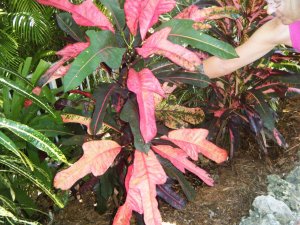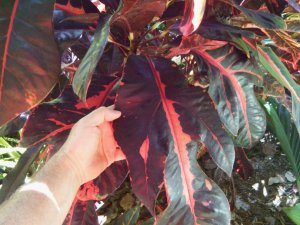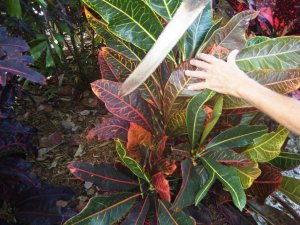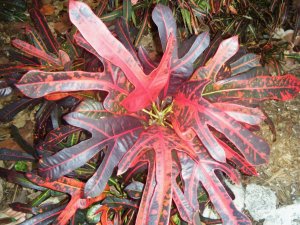fawnridge
Well-Known Member
- 1,430
- 04/07/09
- 49
- 68
I'll let Judy and Jim give you the correct names for each of the varieties below, but I believe I can offer a scientific explanation for the massive leaf growth these plants exhibit in the Keys.
While quite a bit of it is simple environment - hot, humid nights that extend the daily growth cycle immeasurably - the rest of the equation is found in the earth. The Glock's garden is essentially a huge mistbed. Each plant has a drip emitter that runs for 20 minutes every day of the week. Now, normally you'd think that would be too much water, especially with all the rain they get that far south. The solution is in the soil - a thin layer of top soil and then porous coral rock that allows the water to filter away. Add some fertilizer to the system and you get plants with leaves larger than dinner plates.
There's also quite a bit of shade in their garden and that will make anyone's Crotons grow much larger leaves, but without the natural mistbed created by coral rock, you aren't going to get the same results. To confirm my suspicions, I asked them what effects they noticed moving a plant from the Keys to Ft. Myers and the answer was obvious - smaller leaves. Again, environmental conditions are vastly different, as is the soil.
All of this leaves me wondering - should I dig up my garden and rebuild it with a coral rock base, outfitted with a drip system or just have another scotch and leave things as they are?










While quite a bit of it is simple environment - hot, humid nights that extend the daily growth cycle immeasurably - the rest of the equation is found in the earth. The Glock's garden is essentially a huge mistbed. Each plant has a drip emitter that runs for 20 minutes every day of the week. Now, normally you'd think that would be too much water, especially with all the rain they get that far south. The solution is in the soil - a thin layer of top soil and then porous coral rock that allows the water to filter away. Add some fertilizer to the system and you get plants with leaves larger than dinner plates.
There's also quite a bit of shade in their garden and that will make anyone's Crotons grow much larger leaves, but without the natural mistbed created by coral rock, you aren't going to get the same results. To confirm my suspicions, I asked them what effects they noticed moving a plant from the Keys to Ft. Myers and the answer was obvious - smaller leaves. Again, environmental conditions are vastly different, as is the soil.
All of this leaves me wondering - should I dig up my garden and rebuild it with a coral rock base, outfitted with a drip system or just have another scotch and leave things as they are?










